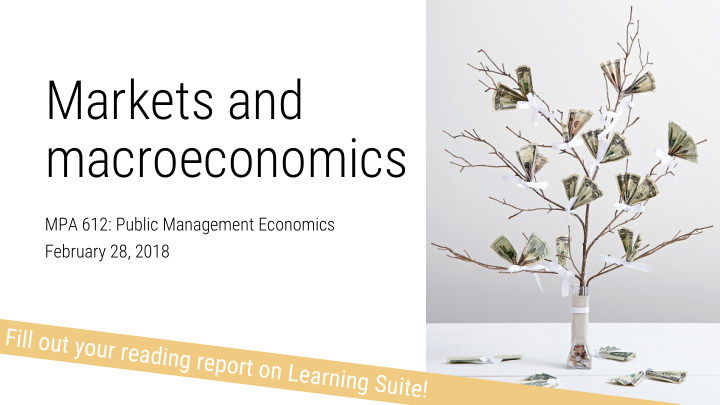



Markets and macroeconomics MPA 612: Public Management Economics February 28, 2018 F i l l o u t y o u r r e a d i n g r e p o r t o n L e a r n i n g S u i t e !
Current events
Plan for today Competition in a price-taking world What is macroeconomics? What is money? Monetary and fiscal policy
Competition in a price-taking world Messing with capitalism and competition to be more capitalistic and competitive
Price-making firm Price-taking firm Sets P and Q to maximize π Sets Q to maximize π, given P MC < P MC = P Deadweight loss Pareto efficient Advertising and marketing Little advertising (public good) Lobbying to influence politics Little lobbying (public good) Research, innovation, Little incentive for innovation prevention of copying because of risk of copying
What is macroeconomics? Voodoo, for real
Microeconomics How individuals and firms make decisions and interact and influence markets Macroeconomics How national and global economies work
Things macroeconomists worry about Output Income Growth Unemployment Inflation Interest rates Fiscal policy Monetary policy
People have… opinions…
What is money?
Where does money come from?
Banking in Smallville, USA
Fractional reserve banking Money is created through lending What happens when lending doesn’t match risk? (o hi 2008)
Monetary and fiscal policy Macroeconomic brain surgery
The Federal Reserve System
Purposes of the Fed Regulate banks and keep financial plumbing running Use monetary policy to control inflation and unemployment This dual mandate is unique to the Fed. Other central banks like the ECB only care about inflation.
Money supply How much money exists
Type of money M0 MB M1 M2 M3 M4 Notes and coins in circulation (outside Federal Reserve Banks and the vaults of ✓ ✓ ✓ ✓ ✓ ✓ depository institutions) (currency) ✓ Notes and coins in bank vaults (vault cash) Federal Reserve Bank credit (required reserves and excess reserves not physically ✓ present in banks) ✓ ✓ ✓ ✓ Traveler's checks of non-bank issuers ✓ ✓ ✓ ✓ Demand deposits Other checkable deposits (OCDs), which consist primarily of negotiable order of ✓ ✓ ✓ ✓ withdrawal (NOW) accounts at depository institutions and credit union share draft accounts. ✓ ✓ ✓ Savings deposits Time deposits less than $100,000 and money-market deposit accounts for ✓ ✓ individuals Large time deposits, institutional money market funds, short-term repurchase and ✓ other larger liquid assets ✓ Commercial paper
Money supply How much money exists M0: physical currency MB: M0 + Fed notes and deposits M1: M0 + checks M2: M1 + savings accounts
M1: https://fred.stlouisfed.org/series/M1 M2: https://fred.stlouisfed.org/series/M2
How does the Fed manipulate the money supply? Reserve requirements Discount rate Open market operations https://www.youtube.com/watch?v=wOfQPn9Jwpo https://www.youtube.com/watch?v=1dq7mMort9o
Funding the federal government Congress Treasury Bonds and t-bills $$$ Big banks $$$ Bonds and t-bills The Fed
Fiscal policy Government uses policy levers to influence economy Taxing and spending
Debt and deficits Deficit : Revenue − expenditures in 1 year Debt : All the past deficits added up
Federal government ≠ household Government can create money with Fed/Treasury magic Only real limit to government expenditure is inflation, not taxes; theoretically there could be no need to tax There’s no due date Treasury bonds are exceptionally stable = super low interest rates
Main question Can the economy absorb new government spending without driving inflation? Balancing the federal budget is a helpful trick for curbing inflation, but not all that necessary
Monetary policy Money supply Interest rates Bonds The Fed Fiscal policy Taxing Public spending Congress (and the Executive Branch)
Recommend
More recommend